A group stage bracket is a tournament format that allows many teams to participate, enabling teams to play against different opponents. It's used in many sports and competitive events worldwide.
Teams are usually divided into four or eight groups in a group stage bracket. Teams play a set number of matches against each other in their group, and points are awarded based on the results. The top teams advance to the knockout stage based on their total points at the end of the group stage.
The group stage bracket is used in soccer, basketball, and volleyball tournaments and competitive video game tournaments. The format makes the competition more balanced and fair since all teams play against different opponents.


